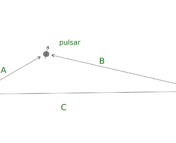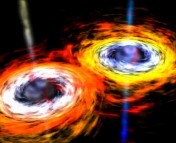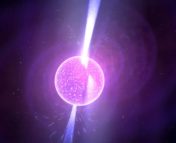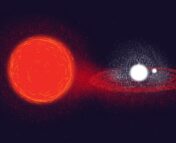Authors: Chengcheng Xin, Chiara M. F. Mingarelli, Jeffrey S. Hazboun
First Author’s Institution: Columbia University, Department of Astronomy, 550 West 120th Street, New York, NY, 10027, USA
Status: Submitted to ApJ
Disclaimer: I am a member of the NANOGrav collaboration but was not involved in this work.
This year’s Nobel Prize in Physics was, in part, awarded to Andrea Ghez and Reinhard Genzel for their discovery of the supermassive black hole (SMBH) at the center of the Milky Way. This was an amazing discovery, and has led many astronomers, including the authors of today’s paper, to look for SMBHs in other galaxies. However the authors of today’s paper are looking not for a single SMBH, but for supermassive black hole binary systems (SMBHBs) which may be formed when two galaxies merge. To do this, they utilize multimessenger astrophysics. First they analyze electromagnetic observations to identify candidate SMBHBs. Then they determine the strength of the gravitational waves emitted by the orbits of these SMBHBs, and predict if they will be detectable with current and future pulsar timing arrays.
Combing for Candidates
Some SMBHBs candidates belong to a class called active galactic nuclei , or AGN, which emit massive amounts of energy that we observe as electromagnetic waves. As the SMBHBs orbit each other, they can cause periodic changes in the brightness, or magnitude, of the light emitted over time. This time-variable light emission is known as a light curve. Many large scale surveys such as the SDSS V or the Catalina Real-Time Transient Survey (CRTS) regularly monitor the light from sources across the sky, resulting in light curves from potential SMBHB sources that span years, like that shown in Figure 1.
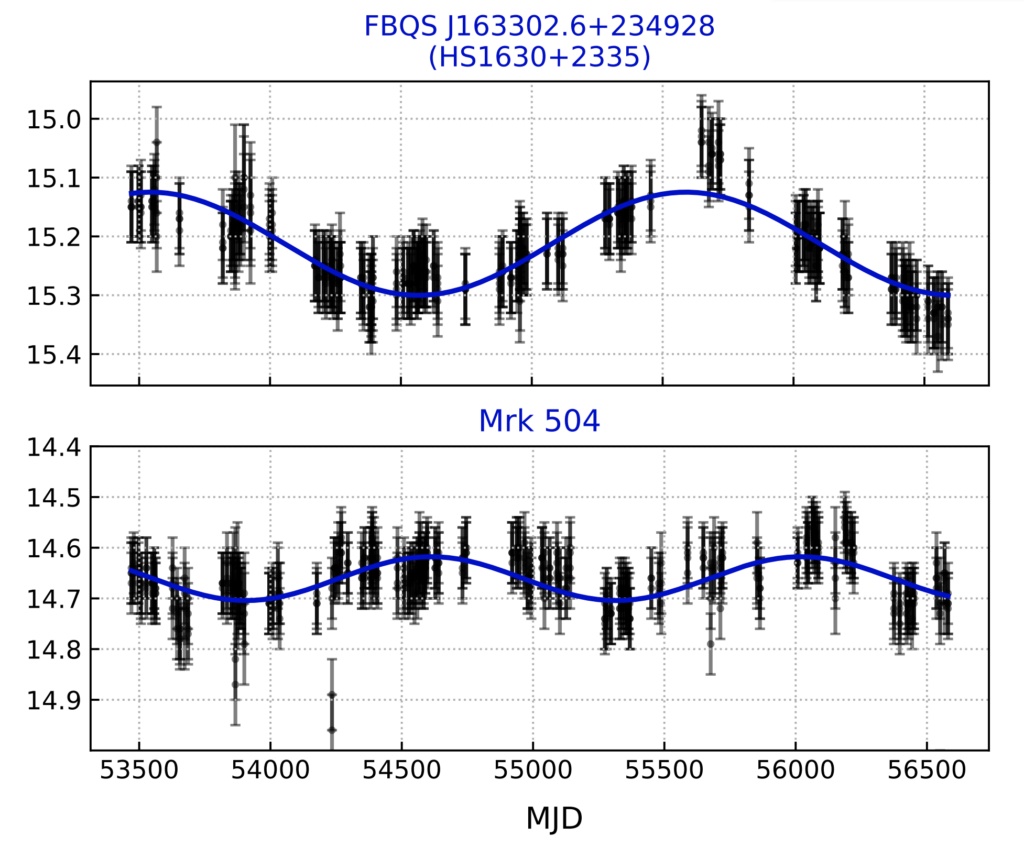
The authors of today’s paper compile a total of 149 of these SMBHB candidates from various catalogs, and then use the source’s distance and masses to predict the frequency and strength, or strain, of the gravitational waves that may be emitted by the binary.
A Galaxy Sized Gravitational Wave Detector
The gravitational waves emitted by SMBHBs will not be like those that have been detected by the Laser Interferometer Gravitational-Wave Observatory (or LIGO), which are emitted at frequencies between 10 and 10,000 Hz. These will be emitted at nanohertz frequencies, which means these binaries will take years to complete one orbit. We can’t detect these low frequency gravitational waves with ground based detectors, so instead we use pulsar timing arrays. Pulsars are neutron stars that emit radio pulses that can be timed, or have their time of arrival at Earth predicted, extremely precisely. As the gravitational waves from these SMBHBs pass between Earth and the pulsar, they will squeeze and stretch the space, making the pulses arrive slightly earlier or later, then predicted. This signal will be different in each pulsar depending on where it is in space, and is discussed in more detail in this astrobite.
Current pulsar timing array experiments such as those done by North American Nanohertz Observatory for Gravitational Waves (NANOGrav), the European Pulsar Timing Array (EPTA), and the Parkes Pulsar Timing Array (PPTA), which collectively make up the International Pulsar Timing Array (IPTA), all regularly search their data for these individual sources of gravitational waves, but none have been found so far. This makes searching for potential candidates for gravitational wave detection through mulitmessenger methods crucial for these experiments.
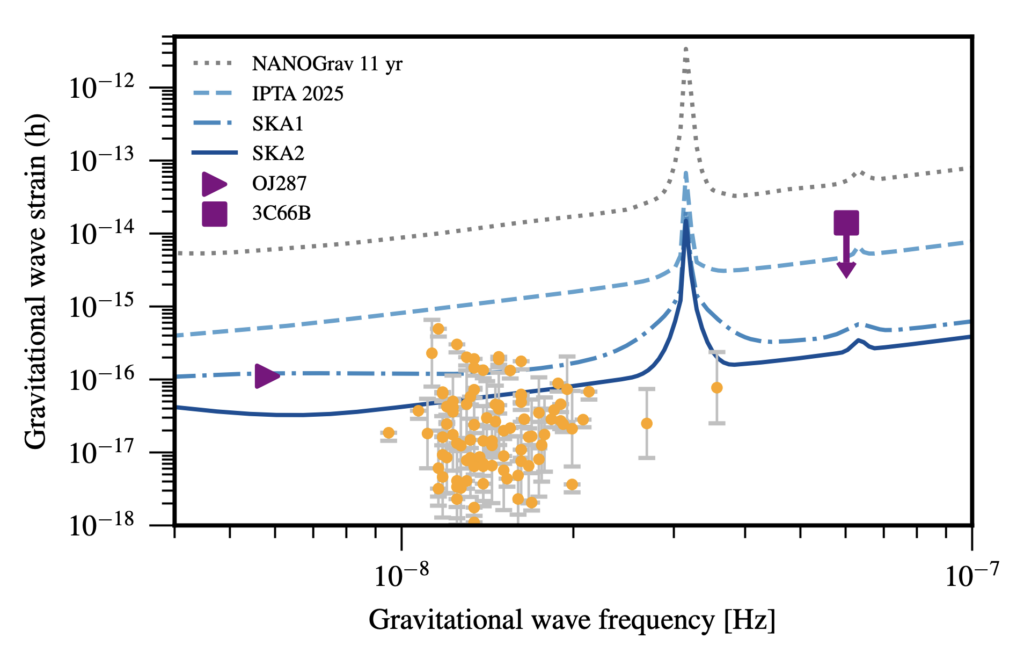
Predicting the Future
The authors of this paper use previous limits set by these pulsar timing arrays, and then use models to extrapolate how sensitive they might be in the future, with particular attention to the IPTA and the Square Kilometer Array (SKA), an array of radio telescopes currently being built which is expected to find and time hundreds of pulsars. The authors then look to see if any of their most promising SMBHB candidates will be detectable in the future, shown in Figure 2 by the candidate points and sensitivity curves and in Figure 3 by the gravitational wave strain needed for the pulsar timing array to detect the source with a signal-to-noise greater than 3 in different parts of the sky. We can see from both of these figures that some SMBHB candidates very well might be detectable, though not for at least a few more years.
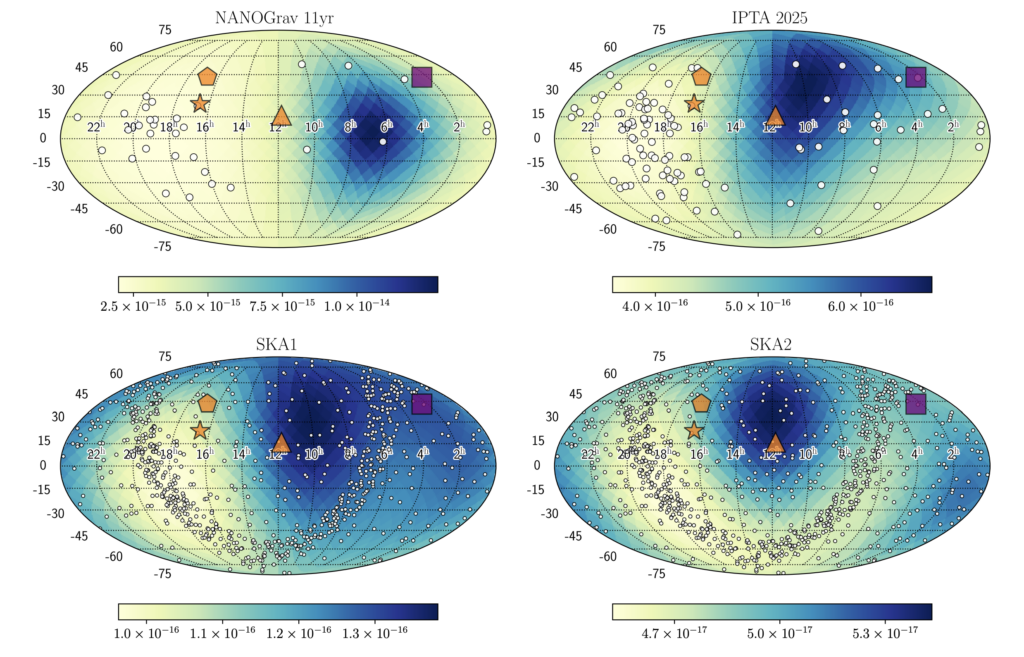
Being able to identify and predict the detectability of potential SMBHB candidates from light curves is crucial for confirming them in the future, as gravitational wave emission is an undeniable signature that the candidate really is a SMBHB. With telescopes like the Vera Rubin Observatory Legacy Survey of Space and Time (LSST) coming online soon, more and more of these candidates will be identified by their light curves. Finding these candidates also allows for targeted gravitational wave searches which may increase the sensitivity by a factor of two! This paper has helped lay the groundwork for multimessenger astronomy as a critical component for detecting SMBHBs in future pulsar timing array data, and shows there is a lot to look forward to!
Astrobite edited by: Abby Waggoner
Featured image credit: AUI/NRAO, NAOJ, and Science/Nicole Rager Fuller

